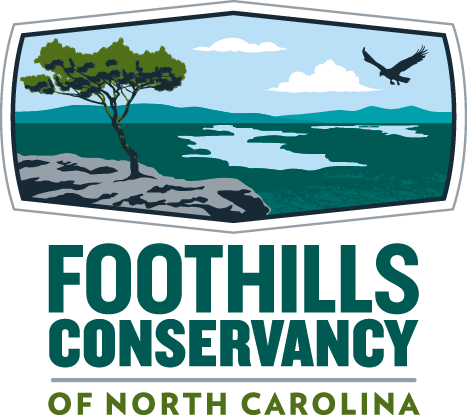FCNC transfers 332 acres on National Wild and Scenic River Wilson Creek to USFS
The 332-acre tract includes over two miles of river frontage in Caldwell County and expands Pisgah National Forest along Wilson Creek.
MORGANTON, N.C. — Foothills Conservancy of North Carolina (FCNC) announces the transfer of 332 acres within the corridor of the National Wild and Scenic River Wilson Creek in Caldwell County to the United States Forest Service. This tract of land, which was donated to FCNC by conservationist Tim Sweeney in 2021, fills in a missing segment of protected public lands along the river, bordered on three sides by the Pisgah National Forest and adjoining the popular Wilson Creek Day Use Area.
The land transfer to federal ownership occurred on October 11, 2023, and forever ensures that this section of the highly significant watershed is protected, conserved and accessible for public recreation opportunities.
“This is a significant stretch of water frontage in the headwaters of creeks and rivers that millions of downstream users rely on,” said Nick Larson, District Ranger for the U.S. Forest Service’s Grandfather Ranger District. “The conservation of this land will directly benefit each and every one of those people by ensuring they have clean and abundant water for years to come.”
“Foothills Conservancy and its public and private partners began conserving land and water in the Wilson Creek watershed back in 2006,” said Andrew Kota, executive director of Foothills Conservancy of NC. “Since that time, our land trust has helped protect 1,275 acres along nine miles of the river for watershed and habitat protection, public access and public use.”
A grant from the National Fish and Wildlife Foundation funded much of the transaction due diligence required by Foothills Conservancy’s national land trust accreditation requirements and the U.S. Forest Service’s federal land transaction specifications; items such as boundary surveying and monumenting, environmental site assessments, appraisals, title examination and insurance and other closing costs.
“In addition to contributing to water security for the greater population, I’m also incredibly excited about the additional public access on Wilson Creek,” exclaims Larson. The property includes 2.3 miles of Wilson Creek along a segment of the river that is designated for recreation under the Wild and Scenic Rivers System. For many years, this section has been highly popular with river recreationists for its fishing, swimming and whitewater boating sites. “The additional public access gained from this property will help the USFS and all of our partners better provide a great recreation experience for all those users,” says Larson.
The section of Wilson Creek that runs through this property not only supports access to downstream whitewater rafting, canoeing and kayaking with challenging Class II-V rapids, but it also boasts beautiful, cascading waterfalls and contains the trailhead for the six-mile Wilson Creek Trail, which connects to other popular trails in the area.
“FCNC is our predominant land conservation partner here in the Grandfather Ranger District,” said Larson. “In the ten years I’ve been stationed here in NC, the Grandfather Ranger District has grown from 183,000 acres to well over 200,000 acres. FCNC is always amazing to work with not just as people, but staying centered on their values of ensuring lands are open and accessible for the public to enjoy. Every parcel I’ve worked with them on has added not only acres, but clear public access.”
To fishermen, Wilson Creek is a coveted, tranquil place to spend a day catching rainbow, brown and brook trout. To families, residents and visitors of the region, it’s a place for soaking up the sunshine, picnicking, or taking a refreshing dip on a warm summer day. To conservationists, though, This land is also environmentally significant for its natural and cultural resource values.
“Essentially, all the water that comes down from Grandfather Mountain funnels through Wilson Creek,” said Larson. “And the water quality along Wilson Creek is incredibly valuable, not only for the phenomenal trout fisheries and the recreational value that clean water provides — but also for the biota here, the rare species occurring just in this section of river,” Larson added.
The parcel of land now in the U.S. Forest Service’s ownership contains aquatic habitat for the brook floater, an at-risk, endangered species of freshwater river mussel. It is also home to the significantly rare Edmund’s snaketail dragonfly and the seagreen darter freshwater fish. Sightings of several vulnerable and significantly rare animal and plant species have also been recorded and documented, both on the property and within a one-mile radius.
Additionally, the improved access to both the national forest and river will allow emergency management services to conduct quicker, more direct rescue efforts in the area, especially in times of heavy recreational use, when other access points may become overcrowded with visitors.
####
Foothills Conservancy of North Carolina is a nationally accredited regional land trust that inspires conservation in Western North Carolina by permanently protecting land and water for the benefit of people and all living things. A 501(c)(3) nonprofit, Foothills Conservancy has conserved more than 70,000 acres in its eight county service area: Alexander, Burke, Caldwell, Catawba, Cleveland, Lincoln, McDowell and Rutherford, in three major river basins: the Broad, Catawba and Yadkin. Information about Foothills Conservancy, including ways to support its work, can be found online at www.foothillsconservancy.org or by calling 828-437-9930.

